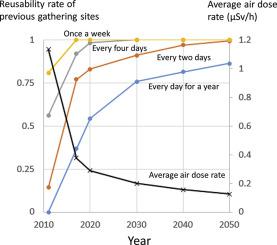Journal of Environmental Radioactivity ( IF 2.3 ) Pub Date : 2020-11-30 , DOI: 10.1016/j.jenvrad.2020.106465 Toshiya Matsuura

|
Edible wild plant/mushroom gathering, an essential food acquisition and outdoor recreation activity in rural areas, has declined in the area near the Fukushima Dai-ichi Nuclear Power Plant (FDNPP) accident in eastern Japan. The present study first evaluated the spatial distribution of potential gathering sites of various edible wild plant/mushroom species before the accident by administering a face-to-face questionnaire survey to local gatherers as well as utilizing the group analytical hierarchy process (AHP) and geographic information systems (GIS). Then, the damage to and future reusability of previous gathering sites were estimated from the perspective of the external radiation dose by overlaying maps of potential gathering sites and the time-series air dose rate (ADR) up to 2050 incorporating different gathering frequency scenarios. The study area is located in Kawauchi village in the eastern Fukushima prefecture, at 12–30 km southwest of FDNPP. The spatial distributions of gathering sites before the accident differed widely among species at the local scale because of their different environmental preferences. In contrast, the temporal variation in the reusability of the gathering sites was notably small among different species. The external radiation dose in the potential gathering sites declined sharply in the early post-accident years and gradually in the later years through the physical decay of radiocesium, i.e., 134Cs and 137Cs, with different half-lives. Moreover, the gathering frequency and heterogeneous distribution of radiocesium substantially affected the temporal variation in reusability for the gathering sites. These results indicate that an early resumption of gathering would be possible by reducing the gathering frequency and avoiding higher ADR areas, whereas it will take a much longer period to resume gathering in areas with higher ADR. Further research is required that considers both internal and external radiation doses in the geospatial context for the restoration and safer use of edible wild plants/mushrooms.
中文翻译:

基于外部辐射剂量评估福岛东部潜在可重复使用的食用野生植物和蘑菇采集场所
在日本东部的福岛第一核电站事故附近,可食用的野生植物/蘑菇聚会是农村地区必不可少的食物获取和户外休闲活动,该地区已经减少。本研究首先通过对当地采集者进行面对面的问卷调查以及利用群体层次分析法(AHP)和地理学来评估事故发生前各种食用野生植物/蘑菇物种潜在采集点的空间分布信息系统(GIS)。然后,从外部辐射剂量的角度,通过覆盖潜在收集地点的地图以及到2050年的时间序列空气剂量率(ADR),并结合不同的收集频率方案,从外部辐射剂量的角度估计了先前收集地点的破坏和未来的可重复使用性。研究区域位于福岛县东部的川内村,在FDNPP西南12-30 km。由于环境偏好的不同,事故发生前采集地点的空间分布在当地物种之间差异很大。相反,在不同物种之间,采集点可重复使用性的时间变化非常小。在事故发生后的早期,潜在聚集点的外部辐射剂量急剧下降,而在后来的几年中,由于放射性铯的物理衰减,其辐射剂量逐渐下降,即 由于环境偏好的不同,事故发生前采集地点的空间分布在当地物种之间差异很大。相反,在不同物种之间,采集点可重复使用性的时间变化非常小。在事故发生后的早期,潜在聚集点的外部辐射剂量急剧下降,而在后来的几年中,由于放射性铯的物理衰减,其辐射剂量逐渐下降,即 由于环境偏好的不同,事故发生前采集地点的空间分布在当地物种之间差异很大。相反,在不同物种之间,采集点可重复使用性的时间变化非常小。在事故发生后的早期,潜在聚集点的外部辐射剂量急剧下降,而在后来的几年中,由于放射性铯的物理衰减,其辐射剂量逐渐下降,即134 Cs和137 Cs,半衰期不同。此外,放射性铯的收集频率和异质分布大大影响了收集地点可重复使用性的时间变化。这些结果表明,可以通过减少收集频率并避免较高的ADR区域来尽早恢复收集,而在具有较高ADR的区域中恢复收集将花费更长的时间。需要进一步的研究,在地理空间范围内考虑内部和外部辐射剂量,以恢复和更安全地食用野生植物/蘑菇。



























 京公网安备 11010802027423号
京公网安备 11010802027423号